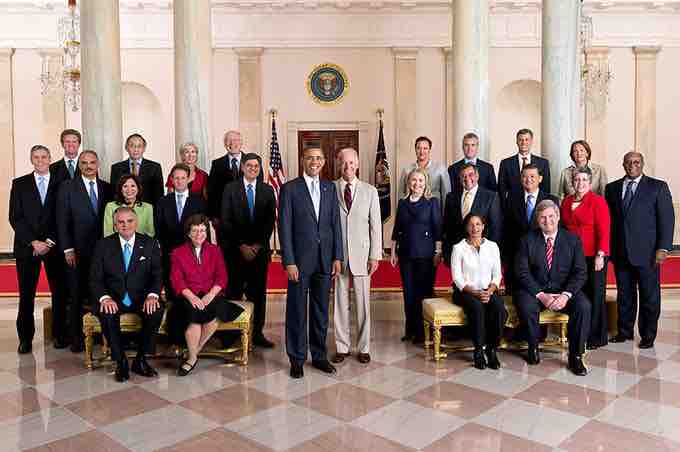Introduction
The Cabinet of the United States is composed of the most senior appointed officers of the executive branch of the federal government of the United States, who are generally the heads of the federal executive departments. The existence of the Cabinet dates back to the first President of the United States, George Washington, who appointed a Cabinet of four men: Secretary of State Thomas Jefferson, Secretary of the Treasury Alexander Hamilton, Secretary of War Henry Knox, and Attorney General Edmund Randolph to advise him and to assist him in carrying out his duties.
All Cabinet members are nominated by the President and then presented to the Senate for confirmation or rejection by a simple majority. If they are approved, they are sworn in and begin their duties. Aside from the Attorney General and the Postmaster General (when it was a Cabinet position), they all receive the title of Secretary. Members of the Cabinet serve at the pleasure of the President, which means that the President may dismiss them or reappoint them (to other posts) at will. Members of the Cabinet direct their own departments; however, all of the power that they have derives from the President, in that while they may advise the President, they carry the President's directives. In other words, the Cabinet may help shape policy, but they do not typically drive or direct policy.
In Federal Law and the Constitution
There is no explicit definition of the term "Cabinet" in either the U.S. Constitution, the United States Code, or the Code of Federal Regulations. There are occasional references to "cabinet-level officers" or "secretaries," which when viewed in their context do refer to the "Heads of the Executive Departments." Executive Schedule refers to the highest-ranked appointed positions in the executive branch of the U.S. government. The President of the United States, an elected official, appoints incumbents to these positions, most of them with the advice and consent of the Senate. They include members of the President's Cabinet as well as other subcabinet policy makers. There are five pay rates within the Executive Schedule, usually denoted with a Roman numeral with I being the highest level and V the lowest.
The President of the United States has the authority to nominate members of his or her cabinet to the United States Senate for confirmation under Article II, Section II, Clause II of the United States Constitution.

U.S. Cabinet
President Barack Obama and Vice President Joe Biden pose with the full Cabinet for an official group photo in the Grand Foyer of the White House, July 26, 2012. These included U.S. Permanent Representative to the United Nations Susan Rice, Attorney General Eric H. Holder, Jr., Secretary of State Hillary Rodham Clinton, Defense Secretary Leon Panetta, Homeland Security Secretary Janet Napolitano, Health and Human Services Secretary Kathleen Sebelius.
Cabinet Positions
The Secretary of State designate is reviewed and presented to the full Senate by the Senate Foreign Relations Committee. John Kerry is the current Secretary of State for President Obama's second term, replacing Hillary Clinton. The Secretary of the Treasury is reviewed by the Senate Finance Committee. Jack Lew is Secretary of the Treasury. Ashton Carter is Secretary of Defense.
The confirmation of the office of Attorney General is overseen by the Senate Judiciary Committee. Eric Holder, Obama's first-term Attorney General was replaced by Loretta E. Lynch for the second term.